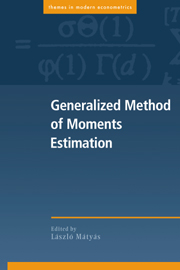Book contents
- Frontmatter
- Contents
- Contributors
- Preface
- 1 Introduction to the Generalized Method of Moments Estimation
- 2 GMM Estimation Techniques
- 3 Covariance Matrix Estimation
- 4 Hypothesis Testing in Models Estimated by GMM
- 5 Finite Sample Properties of GMM estimators and Tests
- 6 GMM Estimation of Time Series Models
- 7 Reduced Rank Regression Using GMM
- 8 Estimation of Linear Panel Data Models Using GMM
- 9 Alternative GMM Methods for Nonlinear Panel Data Models
- 10 Simulation Based Method of Moments
- 11 Logically Inconsistent Limited Dependent Variables Models
- Index
10 - Simulation Based Method of Moments
Published online by Cambridge University Press: 04 February 2010
- Frontmatter
- Contents
- Contributors
- Preface
- 1 Introduction to the Generalized Method of Moments Estimation
- 2 GMM Estimation Techniques
- 3 Covariance Matrix Estimation
- 4 Hypothesis Testing in Models Estimated by GMM
- 5 Finite Sample Properties of GMM estimators and Tests
- 6 GMM Estimation of Time Series Models
- 7 Reduced Rank Regression Using GMM
- 8 Estimation of Linear Panel Data Models Using GMM
- 9 Alternative GMM Methods for Nonlinear Panel Data Models
- 10 Simulation Based Method of Moments
- 11 Logically Inconsistent Limited Dependent Variables Models
- Index
Summary
The estimation of unknown parameters generally involves optimizing a criterion function based on the likelihood function or a set of moment restrictions. Unfortunately, for many econometric models the likelihood function and/or the relevant moment restrictions do not have a tractable analytical form in terms of the unknown parameters rendering thereby the estimation by maximum likelihood (ML) or the generalized method of moments (GMM) infeasible. This estimation problem typically arises when unobservable variables enter the model nonlinearly, leading to multiple integrals in the criterion function, which cannot be evaluated by standard numerical procedures. Prominent examples of such models in financial econometrics are continous–time models of stock prices or interest rates and discrete–time stochastic volatility models.
Until recently, estimation problems due to the lack of some kind tractable criterion function were often circumvented by using approximations of the model producing criterion functions simple enough to be evaluated. However, using such approximations may lead to inconsistent estimates of the parameters of interest. An alternative solution in such cases which has received increased attention over the last few years, is the use of Monte Carlo simulation methods to compute an otherwise intractable criterion function. Seminal for the development of this type of estimation procedures were the contributions of McFadden [1989] and Pakes and Pollard [1989] who introduced the Method of Simulated Moments (MSM) in a cross sectional context. This approach, which was extended to time series applications by Lee and Ingram [1991] and Duffie and Singleton [1993], modifies the traditional GMM estimator by using moments computed from simulated data rather than the analytical ones.
- Type
- Chapter
- Information
- Generalized Method of Moments Estimation , pp. 275 - 300Publisher: Cambridge University PressPrint publication year: 1999



